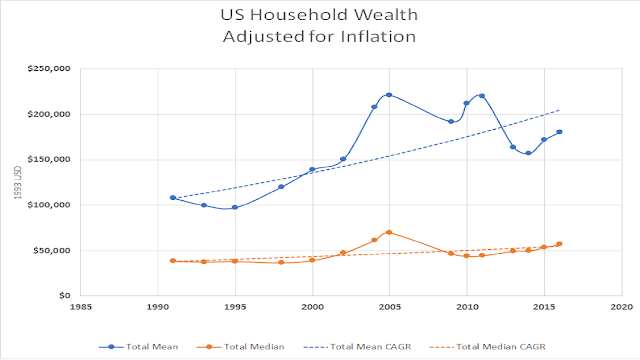Taxman
Let me tell you how it will be
There's one for you, nineteen for me
Cause I'm the taxman yeah, I'm the taxman
Taxes should be a
way to grow the economy, not to increase
inequity.
No one likes paying
taxes. Taxes are levied to raise revenue
for governments. In the United States, the principal source of federal
government revenue is the income tax. However,
the purpose of the income tax code is not only to collect revenue. It is enacted to promote economic growth, while
arguably not unnecessarily adversely affecting various economic sectors. Income inequality is a measure of how the
poor (lower income percentiles) compare to the rich ( upper income percentiles). A proposed measure of income inequality is the
ratio of Mean household income (i.e. total income divided by total households),
divided by Median household income ( i.e. the income above, or below, which 50%
of the households occur). For a perfect
normal distribution of household income, the mean and median would be the same.
A measure of success of the income tax code might be that total income increases,
but the income inequity does not increase.
The Federal Reserve Bank of St Louis provides Mean and Median household incomes, as reported by the US Census. The reported Mean and Median household incomes
are shown in Figure
1.
Figure 1 Mean And Median US Household Income: All Years Current
Dollars
If the goal of the Tax Acts were to increase economic
growth, those Acts have fallen below an Compound Annual Growth trend line established
by income from all years. Also, from
that figure, the gap between Mean and Median
household incomes has been increasing over time.
To account for inflation, the reported household incomes
were adjusted by the Bureau of Labor Statistics Consumer Price Index, CPI, to convert incomes to 1967 dollars ( any year
could be used as an index, which would change the values on the y-axis, but
would not change the data or curves because the impact of inflation would be
the same.) These results are shown in Figure
2.
Figure 2 Mean and Median US Household Income, Adjusted
For Inflation, By Tax Act
The major Tax Acts during this period are shown, which
regress very well to the reported household incomes. The analysis does not include the impact of
the Tax Cut and Jobs Act of 2017 because it was signed in law in December of
2017 and not enough time yet has occurred to compute its impact on household
income. Shown in Table 1
is the Compound Annual Growth Rate, CAGR, computed for the reported respective mean and
median household incomes during these periods. If the intent of the Tax Acts was
to promote economic growth, then arguably
growth has been less during each of Tax Act periods. What has occurred is that the gap between
mean and median incomes has increased during the period of these Tax Acts.
Table 1 Growth Rate During Periods Of Tax Acts.
|
pre 1981
|
1981-1990
|
1991-2001
|
2002- 2018
|
Mean Income
CAGR
|
2.30%
|
1.63%
|
1.93%
|
0.40%
|
Median Income CAGR
|
2.23%
|
1.21%
|
1.46%
|
0.13%
|
While the Tax Acts were adopted during, or immediately following,
economic downturns, recessions, economic downturns, and recoveries have also occurred
during periods with no changes to the tax codes. The official National Bureau of Economic Research
beginning and ending dates of recessions are shown in Table 2. There have been
more recessions than there have been changes to the Tax Code during the
reported period. Based on the reported incomes,
it is possible to recover from a recession without any corresponding changes to the Tax Code.
Table 2 NBER Reported
Recessions Corresponding to the Years In Figures 1 And 2
Beginning
date
|
Ending date
|
1953-07-01
|
1954-05-01
|
1957-08-01
|
1958-04-01
|
1960-04-01
|
1961-02-01
|
1969-12-01
|
1970-11-01
|
1973-11-01
|
1975-03-01
|
1980-01-01
|
1980-07-01
|
1981-07-01
|
1982-11-01
|
1990-07-01
|
1991-03-01
|
2001-03-01
|
2001-11-01
|
2007-12-01
|
2009-06-01
|






